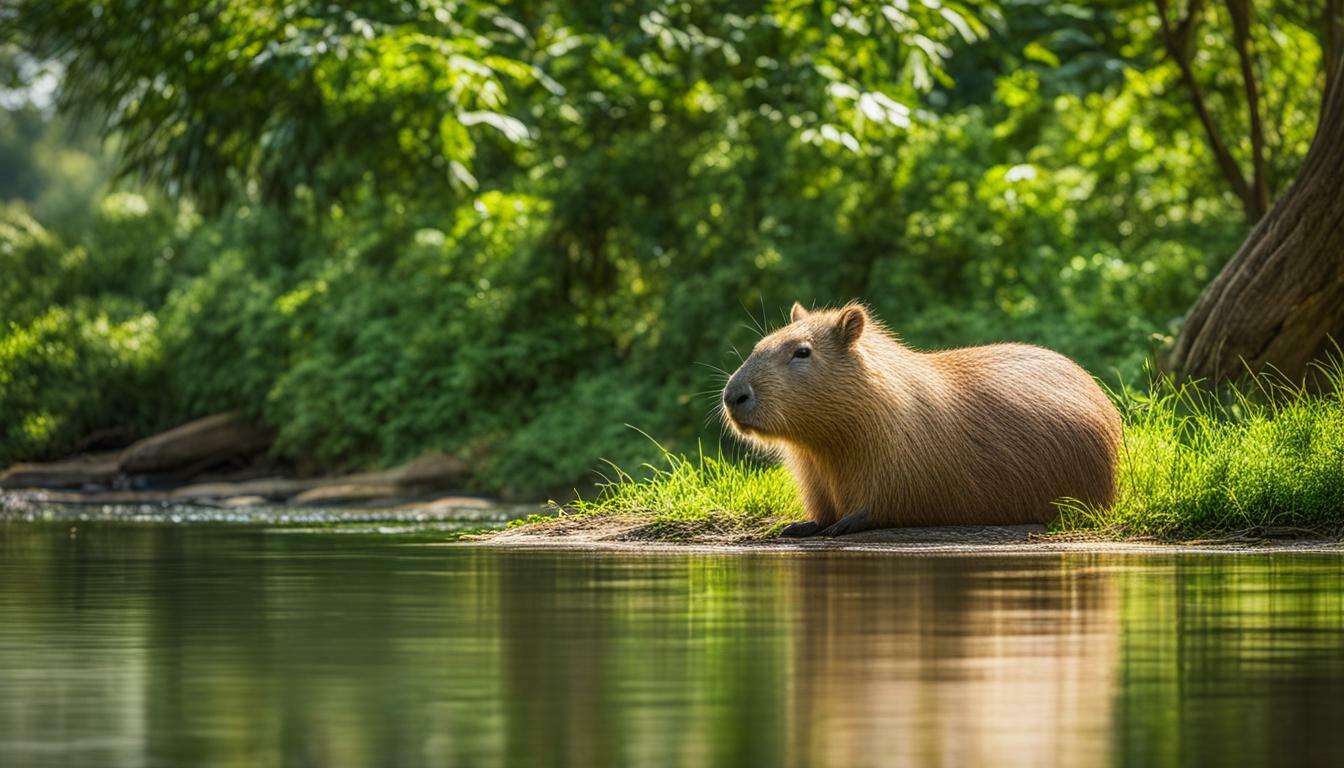Capybaras, the world’s largest rodents native to South America, are renowned for their calm and friendly nature.
These fascinating creatures have captured the attention of many due to their incredible ability to remain relaxed and composed in various situations.
Their behavior and temperament set them apart from other animals, making them truly unique.
Key Takeaways:
- Capybaras are known for their calm and friendly nature.
- They are the world’s largest rodents and are native to South America.
- They live in social groups and have a hierarchy within their groups.
- Capybaras are mostly herbivores and consume grasses and aquatic plants.
- Their social lifestyle and the presence of lookouts within their groups help them relax and reduce stress.
The Social Lifestyle of Capybaras
Capybaras live in social groups and establish a hierarchy, which allows them to relax and reduce stress.
These social animals are highly dependent on the companionship of their fellow capybaras. Living in groups not only provides a sense of security, but also fosters a harmonious environment that contributes to their overall chill nature.
Within their social structure, capybaras display various behaviors and characteristics that promote relaxation and a calm demeanor.
One fascinating aspect of capybara social behavior is their ability to establish a hierarchy within their groups.
This hierarchy helps maintain order and minimizes conflict, ultimately reducing stress among individuals.
Dominant capybaras play a crucial role in leading and protecting the group, while subordinate capybaras find comfort in following and relying on their leaders.
With clearly defined roles and responsibilities, capybaras can peacefully coexist, promoting a relaxed atmosphere.
In addition to their social structure, capybaras have developed unique characteristics that contribute to their chill nature.
These herbivores primarily consume grasses and aquatic plants, allowing them to maintain a steady diet without the need to actively hunt for food.
Their grazing behavior is a soothing activity, reinforcing their calm and relaxed demeanor. Furthermore, capybaras have the ability to form close bonds with their group members, providing emotional support and companionship that helps alleviate stress.
| Capybara Relaxation | Capybara Characteristics |
|---|---|
| Living in social groups reduces stress | Herbivorous diet promotes a relaxed state |
| Hierarchical structure minimizes conflict | Forming close bonds within the group provides emotional support |
| The grazing behavior of capybaras is soothing | Capybaras have a calm and gentle nature |
| Companionship with fellow capybaras promotes relaxation | Group dynamics contribute to their overall chill demeanor |
The Importance of Lookouts
Within their social lifestyle, capybaras employ a fascinating strategy to stay vigilant and maintain a peaceful environment.
They designate certain individuals within the group as lookouts, responsible for keeping a watchful eye on the surroundings and alerting others of any potential threats.
This system ensures that capybaras can relax and engage in leisure activities, such as grooming or basking in the sun, while knowing that they have a lookout to rely on.
By sharing the responsibility of vigilance, capybaras can confidently unwind and enjoy their social interactions.
“Living in social groups not only provides a sense of security, but also fosters a harmonious environment that contributes to their overall chill nature.”
In summary, the social lifestyle of capybaras plays a significant role in their chill demeanor. Living in social groups and establishing a hierarchy allows capybaras to relax and reduce stress.
Their grazing behavior, herbivorous diet, and close bonds within the group contribute to their overall calm and gentle nature.
The presence of lookouts further enhances their ability to unwind and enjoy their social interactions. By understanding the social dynamics of capybaras, we gain insight into why they are known for their chill disposition.
Capybaras as Masters of Relaxation
The serene capybaras find relaxation by engaging in activities like soaking in water and basking in the sun.
These large rodents are natural swimmers and spend a significant amount of time in the water, which helps them cool down and unwind.
Capybaras are known to form groups and gather around bodies of water, creating a sense of community and tranquility.
In addition to their aquatic adventures, capybaras also enjoy sunbathing. They can often be found lounging on the riverbanks, soaking up the warmth of the sun’s rays.
This behavior not only helps them regulate their body temperature but also provides them with a peaceful and calming environment.
Capybaras are herbivores, and their diet consists mainly of grasses and aquatic plants. Grazing allows them to remain in a relaxed state, as they leisurely consume their preferred vegetation.
This peaceful dining experience further contributes to their overall sense of tranquility.
The relaxed nature of capybaras can be attributed to their social lifestyle and the absence of serious predators in their habitats.
Living in large groups helps them establish a strong sense of camaraderie and security, allowing them to let their guard down and unwind.
With their gentle and calm demeanor, capybaras have also become popular as therapy animals, providing comfort and relaxation to humans in need.
The Relaxation Habits of Capybaras
| Relaxation Activities | Description |
|---|---|
| Soaking in Water | Capybaras spend a significant amount of time in water, engaging in playful and relaxing behavior. |
| Basking in the Sun | They enjoy sunbathing, lying on riverbanks and absorbing the warmth of the sun’s rays. |
| Grazing on Vegetation | Feeding on grasses and aquatic plants helps capybaras maintain a state of relaxation while satisfying their herbivorous diet. |
In conclusion, capybaras are truly masters of relaxation. Their natural inclination for water activities, sunbathing, and leisurely grazing contributes to their calm and tranquil nature.
Their social lifestyle and the absence of serious predators further enhance their ability to unwind and find peace in their environment.
The Gentle Nature of Capybaras
Capybaras are known for their gentle disposition and are often sought after as therapy animals due to their soothing presence.
These chill animals have a remarkable ability to create a calming atmosphere wherever they go. Their friendly and docile nature makes them a popular choice for individuals seeking comfort and relaxation.
Capybaras, as the world’s largest rodents, possess unique characteristics that contribute to their gentle nature.
With their round bodies and a cute button-like nose, these creatures exude an undeniable charm. Their soft, thick fur invites gentle strokes and provides a sensory experience that can help alleviate stress and promote a sense of tranquility.
In addition to their physical attributes, capybaras’ behavior also adds to their gentle nature. These social animals prefer to live in groups, forming strong bonds with their fellow capybaras.
Within these groups, there is a hierarchy that promotes a peaceful coexistence. Each member understands their role, which helps reduce conflicts and ensures a harmonious environment.
| Gentle Nature Characteristics | Description |
|---|---|
| Relaxed and Calm Demeanor | Capybaras are known for their laid-back attitude and ability to relax in various situations, making them ideal companions for stress-free interactions. |
| Therapeutic Presence | The soothing presence of capybaras has been found to have therapeutic effects, providing comfort and emotional support to individuals in need. |
| Tolerance and Acceptance | Capybaras possess a remarkable tolerance towards other animals, displaying acceptance and non-aggressive behavior even towards different species. |
Whether they are grazing by the water’s edge or enjoying a leisurely swim, capybaras radiate a sense of tranquility.
Their gentle nature, combined with their remarkable ability to adapt and relax in various environments, makes them the epitome of chill animals.
So next time you encounter a capybara, take a moment to appreciate their serene presence and let their calmness wash over you.
Capybaras in the Wild
In the wild, capybaras remain vigilant for predators and can reach impressive speeds when escaping danger.
As the world’s largest rodents, these gentle creatures have adapted to their surroundings to ensure their survival.
Native to South America, capybaras live in social groups known as herds, which consist of several individuals.
Within these herds, there is a hierarchical structure, with dominant capybaras guiding the group’s behavior.
Capybaras are primarily herbivores and rely on a diet of grasses and aquatic plants. They spend a considerable amount of time grazing, often near water bodies where they feel safe.
While grazing, capybaras assign certain members of their herd as lookouts, keeping a watchful eye for any potential threats.
This social lifestyle and the presence of lookouts help capybaras relax and reduce stress, contributing to their overall chill demeanor.
Not only are capybaras excellent swimmers, able to hold their breath for up to five minutes, but they also possess the ability to climb trees.
These unique capabilities allow capybaras to navigate their environment effectively. Their calm and gentle nature make them sought-after as therapy animals, providing comfort and relaxation to humans who interact with them.
| Predator | Speed of Capybara |
|---|---|
| Jaguar | 35 mph |
| Puma | 35 mph |
| American Crocodile | 20 mph |
| Boa Constrictor | N/A (Relies on camouflage) |
In their natural habitat, capybaras face the constant threat of predators. When a potential danger arises, capybaras rely on their ability to run at impressive speeds to escape.
With predators such as jaguars and pumas capable of reaching speeds of 35 mph, capybaras’ agility comes in handy.
Once the threat is gone, capybaras quickly return to their grazing activities, always aware and ready to respond.
The overall chill nature of capybaras can be attributed to various factors, including their social behavior within herds, the absence of serious predators in their habitats, and their remarkable adaptability to different environments.
These unique characteristics make capybaras fascinating creatures to observe and appreciate.
Capybaras: The Swimmers and Tree Climbers
Capybaras are excellent swimmers and can hold their breath for up to five minutes, making water a source of relaxation for them.
Their elongated limbs and webbed feet are perfectly adapted for life in and around the water. Whether it’s a cool river or a tranquil pond, capybaras gracefully glide through the water, effortlessly navigating their aquatic environment.
They have been observed swimming alongside other animals, such as birds and turtles, showcasing their natural affinity for the water.
The Exceptional Swimmers
With their streamlined bodies and powerful muscles, capybaras can propel themselves through the water with ease.
Their large size also acts as an advantage, providing buoyancy and stability. They often swim in groups, forming a tight-knit unit that helps protect them from potential predators.
It is truly a sight to behold as a herd of capybaras elegantly swim in synchronization, showcasing their coordination and cooperation.
“Capybaras have a natural instinct for water and can effortlessly glide through it, showcasing their exceptional swimming abilities.”
In addition to their remarkable swimming skills, capybaras are also proficient climbers. Despite their large size, they are surprisingly agile when it comes to ascending trees and vegetation.
Their sharp claws and strong limbs allow them to climb with ease, enabling them to reach higher foliage and explore their surroundings.
This unique ability to both swim and climb adds to their fascinating repertoire of skills.
A Life of Relaxation
Water serves as a source of relaxation for capybaras. They can often be found soaking in sun-dappled ponds, basking in the warmth while enjoying a peaceful moment.
Being in the water not only helps them cool down but also provides relief from any tension or stress they may have accumulated throughout the day.
It’s their haven, a place where they can unwind, rejuvenate, and find solace.
A table showing capybara swimming behavior:
| Behavior | Description |
|---|---|
| Swimming Style | Capybaras swim with a graceful and smooth motion, using their webbed feet to paddle through the water. |
| Social Swimming | They often swim in groups, forming a tight-knit unit and displaying their synchronized swimming skills. |
| Water Relaxation | Water is a source of relaxation for capybaras, providing them with a calm and peaceful environment. |
| Climbing Ability | Capybaras are proficient climbers, using their sharp claws and strong limbs to ascend trees and vegetation. |
Watching capybaras gracefully navigate the water and effortlessly climb trees is a testament to their adaptability and versatility.
Their swimming and climbing abilities not only contribute to their overall sense of relaxation but also showcase their unique and intriguing nature.
Therapy Capybaras: A Source of Comfort
Capybaras’ calm and friendly nature makes them ideal therapy animals, offering emotional support and companionship.
Their unique characteristics and behavior make them well-suited for providing comfort to humans in various therapeutic settings.
Interacting with capybaras has been found to have a positive impact on individuals’ mental and emotional well-being.
These gentle creatures have a soothing presence that can help reduce stress and anxiety. Spending time with a capybara can promote relaxation and a sense of tranquility, allowing individuals to find solace in their company.
“Being in the presence of capybaras is like being embraced by nature’s calmness. They have a way of making you forget your worries and feel at peace.” – Capybara Therapy Enthusiast
Therapy sessions involving capybaras often incorporate activities such as gentle petting, grooming, or simply observing their peaceful demeanor.
These interactions can release endorphins, promote a sense of well-being, and provide a much-needed break from the pressures of daily life.
| Benefits of Therapy Capybaras: |
|---|
| Stress reduction: |
| The presence of capybaras can help individuals relax, unwind, and alleviate stress. |
| Companionship: |
| Capybaras offer companionship and emotional support, especially to those feeling lonely or isolated. |
| Mood enhancement: |
| Interacting with capybaras can boost mood, promote feelings of happiness, and increase overall well-being. |
The Absence of Serious Predators
Without major predators threatening them on a regular basis, capybaras can afford to be more relaxed in their surroundings.
This absence of significant threats allows capybaras to focus on their social interactions and leisure activities, resulting in their chill and friendly nature.
Unlike many other animals that constantly need to be on high alert for predators, capybaras can enjoy a more carefree lifestyle.
They can often be seen lounging near bodies of water or grazing peacefully in meadows, unbothered by the constant fear of being hunted.
With their characteristic large size and formidable swimming abilities, capybaras have little to fear from most predators.
While they do face occasional threats from jaguars, caimans, and anacondas, these encounters are relatively rare and capybaras have developed strategies to evade these predators when necessary.
| Predators of Capybaras | Prey of Capybaras |
|---|---|
| Jaguars | Grasses |
| Caimans | Aquatic plants |
| Anacondas | Vegetables |
Thanks to this lack of constant danger, capybaras are able to live their lives with a sense of calmness and ease.
They can fully indulge in their natural behaviors, such as spending time in the water, socializing with their group members, or simply basking in the sun.
Next time you come across a capybara lounging in a peaceful meadow, remember that their chill and relaxed nature is a product of their environment, where the absence of serious predators allows them to live their lives to the fullest.
Conclusion
In conclusion, capybaras possess a natural chill nature that can be attributed to various factors. First and foremost, their social behavior plays a significant role in their relaxed demeanor.
Capybaras are highly social animals, living in groups and establishing hierarchies within their communities.
This strong sense of social cohesion and companionship contributes to their overall calm and friendly disposition.
Additionally, capybaras employ effective stress management techniques. With the presence of lookouts within their groups, they are able to relax and reduce stress by constantly monitoring their surroundings for potential threats.
This vigilant behavior allows capybaras to feel safe and at ease in their environment, further enhancing their chill nature.
Furthermore, the absence of serious predators in their native habitats also contributes to capybaras’ relaxed demeanor.
Without the constant threat of being preyed upon, capybaras are able to graze, swim, and climb trees without fear. This lack of predation pressure allows them to live a more serene and laid-back lifestyle.
Overall, capybaras’ chill nature is a result of their social behavior, stress management techniques, and the absence of serious predators.
It is their unique combination of these factors that makes them the epitome of tranquility in the animal kingdom.
So next time you come across a capybara, take a moment to appreciate their calm and relaxed aura.
FAQ
Why are capybaras known for their chill demeanor?
Capybaras are known for their chill demeanor due to their social behavior and the absence of serious predators.
What are some characteristics of capybaras’ behavior?
Capybaras live in social groups, have a hierarchy within their groups, and are constantly on guard for predators in the wild.
What do capybaras eat?
Capybaras are mostly herbivores and consume grasses and aquatic plants.
How do capybaras manage stress and find relaxation?
Capybaras manage stress and find relaxation through their social lifestyle and the presence of lookouts within their groups.
Can capybaras swim?
Yes, capybaras are excellent swimmers and can hold their breath for up to five minutes.
Do capybaras climb trees?
Yes, capybaras are known to climb trees.
Why are capybaras popular as therapy animals?
Capybaras have a calm and gentle nature, which makes them popular as therapy animals that provide comfort.
What makes capybaras so chill?
Capybaras’ chill nature can be attributed to their social behavior, the absence of serious predators, and their calm and gentle demeanor.




